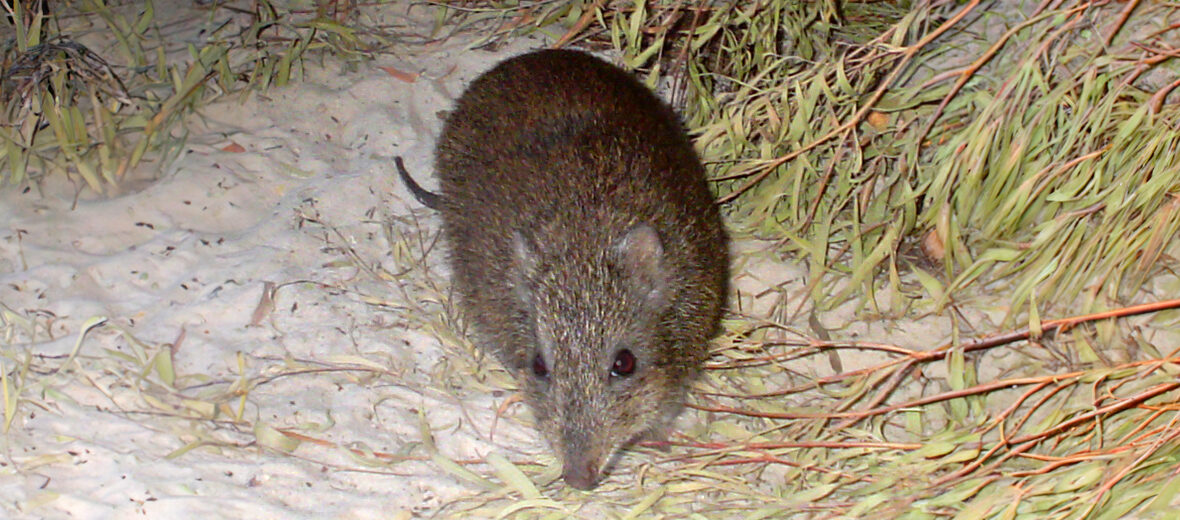
The Gilbert’s potoroo is the rarest marsupial in the world and Australia’s most endangered marsupial. For a long time they were thought to be extinct. They are only found in couple of locations in Australia. They face the threats of fires and fire suppression, and invasive species that result in predation and potential disease. The IUCN lists these critters as Critically Endangered. Their population is, albeit slowly, increasing.
First the Stats…
Scientific name: Potorous gilbertii
Weight: Up to 34 ounces
Length: Up to 11 inches, plus up to a 9.1 inch tail
Lifespan: Up to 10 years
Now on to the Facts!
1.) The Gilbert’s potoroo was 1 of the first species noticed as disappearing after the British colonization.
2.) These critters were presumed to be extinct, having not been spotted in around 100 years, before they were rediscovered in 1994 in Two Peoples Bay Nature Reserve.
3.) Liz Sinclair had been doing research on wallabies, and caught the potoroo in 1 of her traps. She then compared her captured specimen with the skeletons of other past potoroos, and proved it was definitely a Gilbert’s potoroo.
4.) 90% of the species’ habitat was destroyed by a large bushfire. Fortunately, 7 of the potoroos were rescued before the fire came through.
5.) The specific epithet was suggested by Gould to recognize John Gilbert and suggested the common name of Gilbert’s rat kangaroo.
But wait, there’s more on the Gilbert’s potoroo!
6.) A review of historical records for the names in the Nyungar language proposed the adoption of ngilkat as the standard spelling of its preferred common name.
7.) Recently, translocation and conservation efforts have had some success in increasing their populations.
Did you know…?
There were only an estimated 100 individuals, with 10 on Middle Island, 70 on Bald Island, 20 at Waychinicup National Park, and 2 at Two Peoples Bay as of 2018!
8.) They feast on a variety of species of truffle-like fungi (40 various species of fungi have been found in their feces – poop), leaves, stems, and some invertebrates. These critters also might eat fleshy fruits.
9.) Females can birth up to 2 joeys a year. She rears 1 while the 2nd is kept in diapause (delay in development).
10.) The gestation (pregnancy) lasts up to 38 days, and when the joey is born it only measures up to .39 inch. In comparison, a standard grain of rice measures up to .26 inch.
But wait, there’s still more on the Gilbert’s potoroo!
11.) The joey further develops in its mother’s marsupium (pouch) for another 4 months.
12.) In 2001, the Gilbert’s Potoroo Action Group was developed to aid in the education and public awareness of the potoroos. This group also assists with raising funds for their research and captive-breeding programs.
13.) A fatal disease, cryptococcosis, was also discovered among wild populations and may be yet another factor in these critter’s demise.
14.) Indigenous rangers are currently helping to set up and monitor the population on Middle Island, which is around 75 miles (plus a 2.5 hour boat trip) south-east of Esperance. In July 2022, potoroos were seen on camera in a new location, and a sighting of 2 adults and 1 joey showed that they were apparently breeding on the island.
15.) These critters are nocturnal (active at night).
Now a Short Gilbert’s Potoroo Video!
Be sure to share & comment below! Also, check out the Critter Science YouTube channel. Videos added regularly!
Want to suggest a critter for me to write about? Let me know here.
Some source material acquired from: Wikipedia & IUCN
Photo credit: Mick wackers




